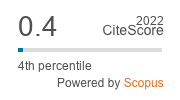Association of okra (Abelmoschus esculentus (L.) Moench) yellow vein mosaic incidence with population of its vectors under Kerala conditions
Keywords:
okra, Abelmoschus esculentus, germplasm, yellow vein mosaic, vectors, whitefly, leaf hopper, Bemisia tabaci, Empoasca devastans, association, populationAbstract
One hundred and one accessions of okra (Abelmoschus esculentus (L.) Moench), collected from various parts of India, were scored for Yellow vein mosaic disease (YVM) incidence and population of two vectors of the disease during summer season during four stages of the crop. The accessions differed significantly for whitefly population during all the three stages of the crop (30, 50 and 70 DAS), while leaf hopper count showed significance only during 50 DAS. Time of infestation differed significantly for white fly at 30 DAS whereas in all other cases, time mean square was non-significant. Correlation coefficients of YVM incidence with vector population computed during different crop stages revealed that morning and evening population of both whitefly and leaf hopper (except for morning population with YVM during final harvest) at 30 DAS had significant association with disease occurrence from 50 DAS to final harvest. Besides, white fly population during both the time at 50 DAS also had influence on YVM incidence during final harvest.
References
Ali M, Hossain M.Z. and Sarkern N.C. (2000) Inheritance of Yellow Vein Mosaic Virus (YVMV) tolerance in a cultivar of okra (Abelmoschus esculentus (L.) Moench). Euphytica, 111(3): 205- 209.
Arumugam R.,Chelliah S. and Muthukrishnan C.R. (1975) Abelmoschus manihot as a source of resistance to bhindi yellow vein mosaic. Madras Agricultural Journal, 62: 310 – 312.
Bhagat A.P., Yadav B.P. and Prasad Y. (2001) Rate of dissemination of okra yellow vein mosaic virus disease in three cultivars of okra. Indian Phytopathology, 54: 488–489.
Duzyaman E. (1997) Okra - Botany and Horticulture. Horticulture Review, 21:41-71.
Fajinmi A.A. and Fajinmi O.B. (2010) Incidence of okra mosaic virus at different growth stages of okra plants (Abelmoschus esculentus (L.) Moench) under tropical condition. Journal of General and Molecular Virology, 2 (1): 28-31.
Gupta V.K. and Paul Y.S. (2001) Diseases of Vegetable Crops. Kalyani Publishers, Ludhiana, Punjab, India.
Jose J. and Usha R. (2003) Bhendi yellow vein mosaic disease in India is caused by association of a DNA â satellite with a begumovirus. Virology, 205(2): 310-317.
KAU (1996) Package of Practices Recommendations: Crops. Eleventh Edition. Kerala Agricultural University, Thrissur, p. 278.
Sastry K.S.M. and Singh S.J. (1974) Effect of yellow vein mosaic virus infection on growth and yield of okra crop. Indian Phytopathology, 27: 294-297.
Varma P.M. (1952) Studies on the relationship of bhindi yellow vein mosaic virus and its vector, the whitefly (Bemisia tabaci). Indian Journal Agricultural Sciences, 22: 75-91.
Varma P.M. (1955) Persistence of yellow vein mosaic virus of Abelmoschus esculentus (L.) Moench in its vector Bemisia tabaci. Indian Journal Agricultural Sciences, 25: 293-302.


